References
al-Alusy, Syihabudin Mahmud bin Abdullah al Husaini, Ruh al Ma’aniy fi Tafsiril Qur’an, Beirut: DKI, tt.
Amanda, Resti, dan Mardianto, Hubungan antara Prasangka Masyarakat terhadap Muslimah Bercadar dengan Jarak Sosial, dalam Jurnal RAP UNP, vol. 5, no. 1, Mei 2014.
al-Sobuny. Muhammad Ali, Rawa’iul Bayan Tafsiru Ayatil Ahkam Minal Quran, Beirut: DKI, 2010.
Bandura, A., Social Learning Theory, New York: General Learning Press, 1977.
Bungin, M. B., Penelitian Kualitatif, Jakarta: Prenada Media Group.kmk, 2007.
Candra, S. A., & Raharjo, B. Institut Agama Islam Negeri (IAIN) Bukittinggi di Sumatra Barat mengimbau dosen dan mahasiswinya untuk tidak mengenakan cadar di lingkungan akademik, February 20, 2018.
Goode, W. J., Sosiologi Keluarga. Jakarta: Bumi Aksara, 2007.
Hafiz, Hukum Memakai Cadar, NU Online, Retrieved from www.nu.or.id, 20 April 2016.
Husna, Fathayatul, Niqab Squad Jogja dan Muslimah Era Kontemporer di Indonesia, dalam Jurnal al-Bayan, UIN ar-Raniry, vol. 24, no. 1, Januari-Juni 2018.
Milles, M. B., Huberman, A. M., & terj Tjetjep Rohendi Rohadi, Analisis data Kualitatif. Jakarta: UI Press, 1992.
Mulyana, D., Metodologi Penelitian Kualitatif, Paradigma Baru Ilmu Komunikasi dan Ilmu Sosial Lainnya. Bandung: PT Remaja Rosdakarya, 2008.
Prasetyo, Irawan, dkk., Teori Belajar Motivasi dan Keterampilan Mengajar, Jakarta: PAU-PPAI, Universitas Terbuka, 2007.
Putra, H., Bercadar, Wajib, Sunah, atau Mubah? Republika, Retrieved from www.republika.co.id, 27 Maret 2015.
Rahman, Alif fatur, Motivasi, Stigma dan Coping Stigma pada Perempuan Bercadar, Dalam Jurnal Psikologi Teori dan Terapan, vol. 7, no. 2, 2017.
Ritzer dan Goodman, Teori Sosiologi Modern, Jakarta: Kencana Predana Media Group, 2011.
Rosyid, Lisa Aisiyah, Problematika Hukum Cadar Dalam Islam: Sebuah Tinjauan Normatif-Historis, dalam Jurnal Ilmiah al-Syir’ah, vol. 16, no. 1, tahun 2018.
Sugiyono, Metode Penelitian Kuantitatif, Kualitatif dan R & D. Bandung: Alfabeta, 2010.
Syaifullah, M., UIN Sunan Kalijaga Yogya Larang Mahasiswi Bercadar, https://nasional.tempo.co/read/1066740/uin-sunan-kalijaga-yogya-larang-mahasiswi-bercadar/full&view=ok Syaifullah Muh, (2018)
Tim Fatwa Majelis Tarjih dan Tajdid Pimpinan Pusat Muhammadiyah, Hukum Tentang Jenggot dan Cadar, Retrieved from www.fatwatarjih.com, 3 Juli 2009.
Zamakhsyari, Abd al Qosim Mahmud ibn Muhammad, al Kasysyaf an Haqaiq al Tanzil fi Wujuh al Ta’wil, Beirut: Dar Ma’rifah, tth.
Zaqzuq, Mahmud Hamdi, An Niqab Adatun wa Laisa Ibadatun: ar-Ra’yu al-Syar’iy fi al-Niqabi bi Aqlami Kubbari al Ulama’, Kairo: DKM, 2008.



